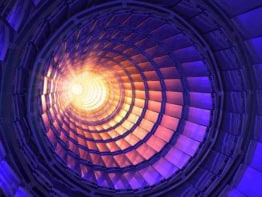Physicists at the University of Michigan have measured the lifetime of ‘orthopositronium’ with the highest precision yet. Positronium is like an ordinary hydrogen atom except that it has a positron and an electron bound together, instead of a proton and electron. This two-body system is unstable and has a very short lifetime, decaying in little over 100 nanoseconds. Until now, however, experiments had always measured lifetimes that did not agree with theory (R S Vallery et al. 2003 Phys. Rev. Lett. 90 203402).

Positronium consists of an electron and a positron – the positively charged antiparticle of the electron – orbiting around each other. If the spins of the two particles point in the same direction, the system is called orthopositronium. During this orbit, the two particles approach each other more and more closely until they finally annihilate one another as they convert to high-energy gamma rays. Measuring these annihilation decay rates provides unique tests of quantum electrodynamics (QED).
QED predicts that positronium has a lifetime of about 142 nanoseconds but previous experiments always measured decay rates that differed from this by over 0.1%. To explain such discrepancies, theorists had to resort to exotic explanations such as the existence of millicharged particles, forbidden numbers of gamma rays and even mirror universes.
Richard Vallery and colleagues created orthopositronium by firing a low-energy positron beam into a special micron-thick nanoporous silica film. Orthopositronium is formed when positrons that have been slowed down by the film capture electrons. The researchers were able to measure how long this took by detecting the annihilation gamma rays in a scintillator. This set-up overcame problems encountered in previous experiments to measure decay rates, performed at Michigan in 1990. These experiments sometimes measured energetic positronium annihilating on the cavity walls of the detector. In the present experiment, only positrons that annihilate their bound electrons are detected.
The researchers measured a lifetime that “is in very good agreement with the current QED calculation” with a decay rate that differs by only about 0.014% from the theoretical value. “We now taking more data to further reduce our systematic and statistical errors with the goal of reporting a final decay rate value with an error of about 0.01%,” Vallery told PhysicsWeb.




